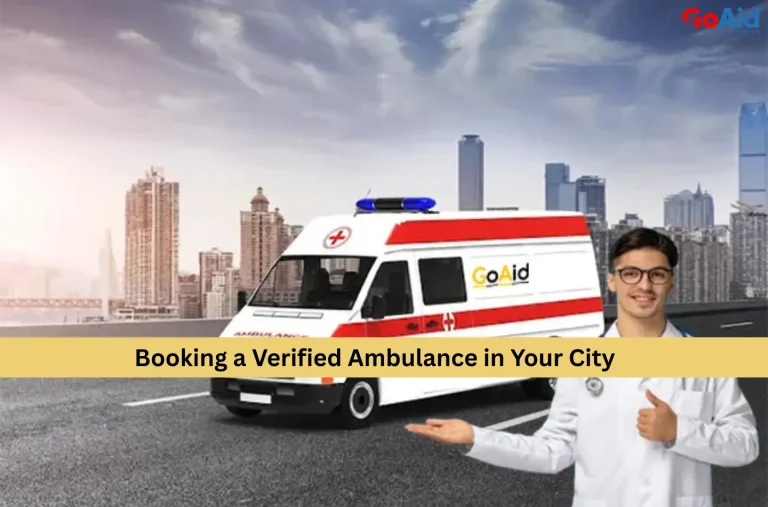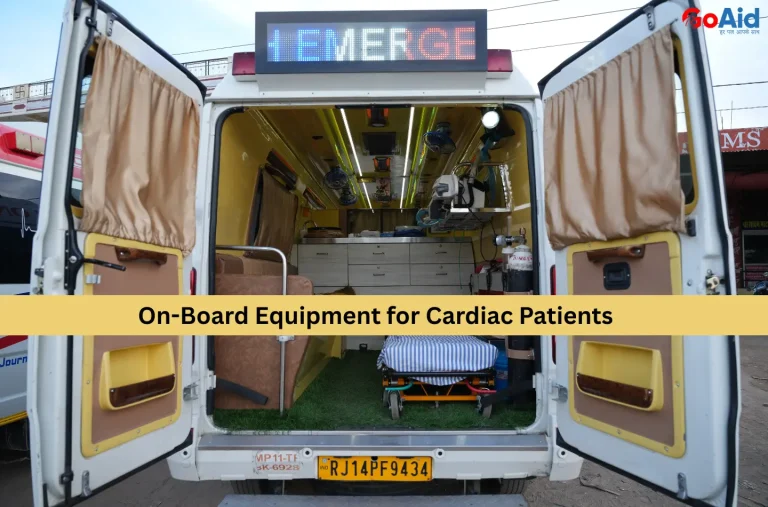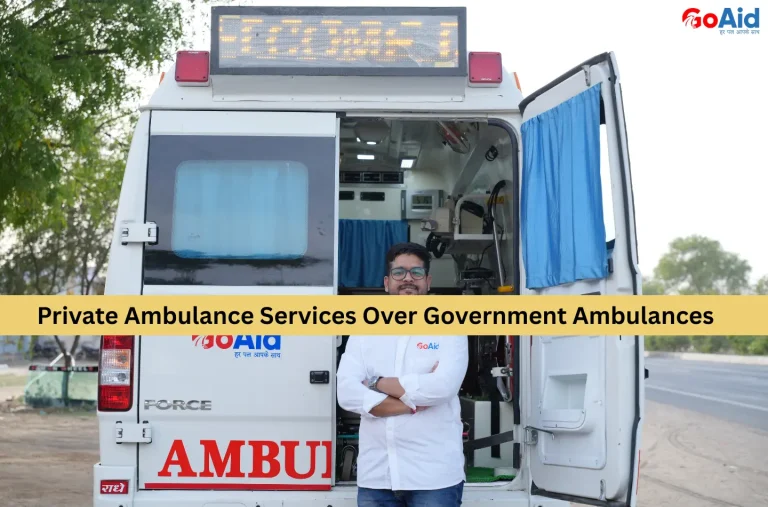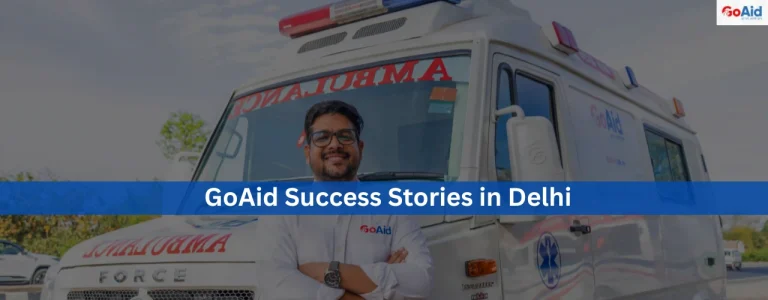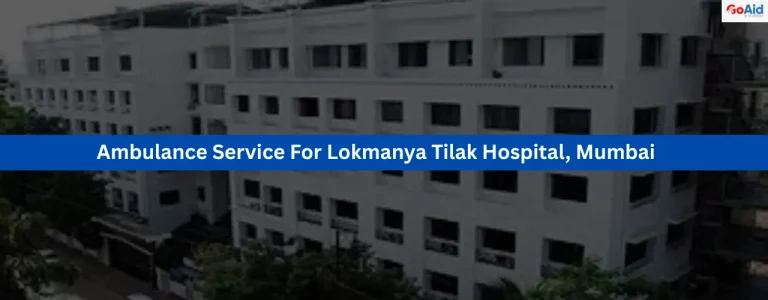During medical emergencies, the skills and experience of Emergency Medical Technicians (EMTs) can make the difference between life and death. Many patients face delayed care or improper handling due to untrained responders, which highlights the importance of having expert EMTs available during emergency transfers.
This is why, in this blog we have provided you with all the details about why trained EMTs are essential, the key competencies they must have, how they stabilize patients before hospital arrival, their role in accidents and cardiac emergencies, how to identify qualified EMTs, and GoAidŌĆÖs standards for professional emergency medical teams. Do you want to know all these information in detail? then read our blog to the end.
So, lets start
What Makes EMTs Essential in Emergency Care
Emergency Medical Technicians (EMTs) are critical in saving lives during pre-hospital care. They provide rapid assessment, stabilization, and treatment to patients before reaching a hospital, bridging the crucial gap between incident and definitive care.
EMTs are trained to handle a wide range of emergencies. This includes trauma, cardiac arrest, respiratory distress, and hypothermia. Their ability to monitor vitals, administer medications, perform CPR, and operate advanced medical equipment ensures patient safety en route.┬Ā
Skilled EMTs reduce mortality by managing complications immediately and preventing deterioration during transport. They communicate with receiving hospitals. This allows medical teams to prepare in advance. EMT presence improves patient confidence and reduces panic in chaotic situations.
In short, trained EMTs act as life-saving professionals, turning minutes into meaningful interventions and ensuring that patients receive timely, professional, and efficient care during every critical emergency. GoAid Ambulance Service maintains highly trained EMTs to deliver such expert support across India.
Checklist: Skills Every Professional EMT Must Have
Professional EMTs require a comprehensive skill set to provide effective emergency care and ensure patient survival during transport.
1. Advanced Life Support Knowledge
Ability to perform ACLS protocols. This includes CPR, defibrillation, and airway management for cardiac and respiratory emergencies.
2. Trauma Care Expertise
Skill in immobilizing fractures, controlling bleeding, and managing spinal injuries to prevent further harm during transit.
3. Patient Assessment Skills
Quickly evaluating patient condition, vitals, and injury severity for immediate, appropriate interventions.
4. Medication Administration
Safe delivery of emergency drugs like anti-arrhythmics, pain relievers, or clot-busters according to patient condition.
5. Oxygen & Ventilation Management
Proficiency in using oxygen devices, ventilators, and suction equipment to maintain proper breathing and oxygenation.
6. ECG & Cardiac Monitoring
Ability to interpret ECG readings and identify arrhythmias or ischemic events en route.
7. Communication & Coordination
Effective interaction with hospitals, paramedics, and patientsŌĆÖ families to relay vital information and instructions.
8. Stress Management
Remain calm under pressure. This makes critical decisions quickly during high-stress emergency scenarios.
9. Equipment Handling
Proper use and maintenance of all ambulance medical devices. This ensures reliability during emergencies.
10. Patient Comfort & Safety
Knowledge of safe lifting, transport, and positioning techniques to minimize additional injury or stress.
How Do EMTs Stabilize Critical Patients Before Hospital?
EMTs play a vital role in stabilizing critical patients. This provides immediate interventions, monitoring vitals, and preventing deterioration during transport, bridging the gap between incident and hospital care.
1. Airway Management
EMTs ensure the patientŌĆÖs airway is clear, using techniques like suctioning, intubation, or oxygen delivery, preventing hypoxia and maintaining proper respiration during transport.
2. Breathing Support
They administer oxygen therapy or ventilatory support to maintain adequate oxygen levels. This reduces the risk of respiratory failure or cardiac complications.
3. Circulation Stabilization
By monitoring blood pressure, pulse, and administering IV fluids or emergency medications, EMTs maintain stable circulation for critically ill or injured patients.
4. Cardiac Monitoring
EMTs use ECG and other monitoring devices to detect arrhythmias or ischemic events. This allows early intervention to prevent cardiac arrest.
5. Bleeding Control
In trauma cases, they apply pressure, bandages, or tourniquets to control hemorrhage. This minimizes blood loss and preventing shock before hospital arrival.
6. Pain Management
Paramedics provide safe, emergency-approved analgesics to relieve pain. This reduces stress on the heart and body during critical situations.
7. Fracture & Spinal Immobilization
EMTs use splints, cervical collars, and backboards to prevent worsening of fractures or spinal injuries during transport.
8. Rapid Assessment & Prioritization
They continuously evaluate patient condition, triaging multiple injuries or complications. This ensures the most urgent care is provided first.
9. Medication Administration
Trained EMTs deliver emergency drugs like anti-arrhythmics, clot-busters, or bronchodilators, following protocols to stabilize the patient safely.
10. Communication With Hospital
EMTs relay patient vitals, interventions, and condition updates to the receiving hospital. This ensures preparedness for immediate treatment upon arrival.
Role of EMTs in Road Accident Cases
EMTs are crucial in road accident emergencies. This provides professional care. This stabilizes injuries, and preventing fatalities during pre-hospital transport. This ensures patients reach hospitals safely and efficiently.
1. Rapid On-Site Assessment
EMTs quickly evaluate accident victims, checking consciousness, airway, breathing, circulation, and injuries to prioritize treatment effectively at the scene.
2. Immediate Life-Saving Interventions
They perform CPR, bleeding control, and airway management on-site, preventing deterioration before hospital arrival.
3. Immobilization of Injuries
Fractures, spinal injuries, and head trauma are stabilized using splints, collars, and backboards to prevent further damage.
4. Pain Control
Paramedics provide emergency-approved pain relief. This reduces stress and preventing shock in accident victims.
5. Monitoring Vitals
Continuous observation of heart rate, blood pressure, oxygen levels, and consciousness ensures early detection of complications.
6. Safe Patient Transport
EMTs use specialized stretchers and vehicles to move patients securely. This minimizes risks during transport to medical facilities.
7. Hemorrhage Management
They apply pressure dressings or tourniquets to control bleeding. This reduces the risk of life-threatening blood loss.
8. Coordination With Hospitals
Real-time updates and communication allow hospitals to prepare emergency teams and necessary equipment before patient arrival.
9. Handling Multiple Casualties
In mass accidents, EMTs triage victims, prioritizing critical patients for immediate care and transport.
10. Emotional Support & Guidance
Paramedics provide reassurance and instructions to patients and bystanders. This helps reduce panic and ensuring cooperation during emergencies.
Importance of Pre-Hospital Decision Making
Pre-hospital decision making by EMTs is crucial for saving lives during emergencies. Rapid, accurate assessment at the scene determines the interventions needed before reaching the hospital. EMTs prioritize patient conditions, identifying life-threatening injuries or complications and deciding which measures to perform immediately.
They evaluate airway, breathing, circulation, vitals, and consciousness levels to determine stabilization strategies. These decisions guide oxygen administration, cardiac monitoring, medication delivery, and immobilization procedures. Quick, informed choices reduce delays in treatment, prevent deterioration, and increase survival rates.
In multi-casualty or accident scenarios, effective decision-making allows EMTs to triage victims efficiently. This ensures critical patients receive care first. For cardiac or respiratory emergencies, these judgments determine if defibrillation, CPR, or ventilatory support is required.
GoAid EMTs are trained to make high-stakes decisions confidently, combining technical skills with experience. This provides life-saving interventions during pre-hospital care and ensuring patients arrive safely and stabilized at medical facilities.
How Do EMTs Help During Cardiac & Respiratory Arrests?
During cardiac and respiratory arrests, EMTs act as first responders. This provides immediate life-saving interventions. They assess consciousness, airway, breathing, and circulation while activating advanced cardiac life support protocols.
CPR is performed with proper technique, and automated or manual defibrillation is applied when needed. EMTs administer oxygen, secure airways, and use ventilators to maintain respiration. Continuous monitoring of vitals ensures any changes are detected and treated promptly.
Emergency medications, like anti-arrhythmics or epinephrine, are given as per protocol to stabilize heart rhythm and blood pressure. Communication with hospitals allows preparation for immediate intervention upon arrival.
EMTs also guide bystanders to assist safely, controlling panic at the scene. Their training minimizes delays, prevents irreversible organ damage, and significantly increases survival chances.
GoAid EMTs are specifically equipped and trained for such emergencies. This ensures professional pre-hospital cardiac and respiratory care.
GoAidŌĆÖs EMT Training & Experience Standards
GoAid ensures that all EMTs undergo rigorous training and maintain high experience standards to deliver life-saving pre-hospital care. EMTs are trained in advanced life support (ACLS), trauma management, airway handling, cardiac monitoring, and emergency medication administration.
Regular skill assessments, simulations, and certifications keep the team updated on best practices. GoAid emphasizes both technical and soft skills. This includes stress management, patient communication, and rapid decision-making in high-pressure situations.
EMTs are required to have hands-on experience in diverse emergency scenarios, from road accidents to cardiac emergencies and critical transfers. Ambulance teams are trained to operate all onboard medical equipment. This includes ventilators, defibrillators, ECG monitors, and oxygen devices.┬Ā
Continuous professional development ensures paramedics can adapt to complex emergencies, provide accurate interventions, and communicate effectively with hospitals and families.
These strict standards make GoAid EMTs highly reliable for emergency medical transport. This offers safety, professionalism, and timely pre-hospital care across India.
How to know if a Paramedic/Ambulance Help is EMTs or Regular Helpers?
Identifying trained EMTs is crucial to ensure professional emergency care and proper pre-hospital intervention. You should not rely on untrained personnel who may be unable to handle life-threatening situations safely.
1. Certification & License
Professional EMTs possess recognized certifications and licenses from authorized medical boards, proving they have undergone formal emergency training, are compliant with national standards, and are qualified to provide pre-hospital care.
2. Advanced Life Support Training
EMTs are trained in ACLS, CPR, trauma management, airway handling, and other emergency protocols. This enables them to perform life-saving interventions immediately, unlike untrained helpers without formal medical knowledge.
3. On-Board Equipment Usage
Certified EMTs can operate ECG monitors, oxygen devices, ventilators, defibrillators, and emergency drug kits efficiently. This ensures patients receive professional care during transport, which untrained personnel cannot provide safely.
4. Patient Assessment Skills
They can quickly assess vital signs, injury severity, and patient condition. This makes informed decisions for immediate interventions to stabilize the patient, something regular helpers are not equipped to do.
5. Medication Administration
Trained EMTs safely administer emergency medications such as anti-arrhythmics, epinephrine, or clot-busting drugs according to protocols, preventing complications that can occur with untrained personnel attempting the same.
6. Real-Time Hospital Communication
EMTs maintain continuous communication with hospitals. This provides updates on patient vitals, interventions performed, and estimated arrival. This ensures hospitals are prepared for immediate treatment.
7. Stress Management & Professional Demeanor
Certified EMTs stay calm and composed under pressure, managing both patients and bystanders efficiently. This reduces panic and ensuring proper care, unlike untrained helpers who may act hastily.
8. Experience in Multiple Emergency Scenarios
EMTs handle various emergencies. This includes cardiac arrests, trauma, respiratory distress, and hypothermia, using hands-on experience to provide optimal care in critical situations.
9. Knowledge of Patient Safety Protocols
They follow strict protocols for safe lifting, proper positioning, and secure transport. This minimizes the risk of injury or worsening conditions during ambulance transfer.
10. Continuous Monitoring & Decision-Making
EMTs continuously monitor vitals, adjust treatments as needed, and make rapid decisions during transit to stabilize patients, a critical skill lacking in untrained ambulance helpers.
How EMTs Reduce Mortality During Transfers?
EMTs significantly reduce mortality during patient transfers by providing professional pre-hospital care. This stabilizes vitals, and preventing complications. This ensures timely and safe arrival at hospitals.
1. Rapid Assessment of Patient Condition
EMTs quickly evaluate airway, breathing, circulation, and injury severity to determine immediate interventions, preventing deterioration and increasing survival chances during transport.
2. Timely Life-Saving Interventions
They perform CPR, defibrillation, oxygen therapy, and other critical measures instantly. This reduces the risk of fatal outcomes en route.
3. Continuous Vital Monitoring
EMTs track heart rate, blood pressure, oxygen saturation, and consciousness, detecting changes early to act before complications worsen.
4. Proper Immobilization Techniques
Spinal injuries, fractures, and trauma are stabilized using collars, splints, and backboards, preventing further harm during transport.
5. Safe Medication Administration
Emergency drugs like anti-arrhythmics, epinephrine, and clot-busters are administered precisely. This minimizes risks and stabilizing patients effectively.
6. Effective Airway & Breathing Management
Trained EMTs maintain open airways, use ventilators, and deliver oxygen, preventing hypoxia and respiratory failure during critical transfers.
7. Real-Time Communication with Hospitals
Continuous updates allow hospitals to prepare emergency teams. This ensures immediate treatment upon arrival and reducing time-sensitive risks.
8. Prioritization in Multi-Casualty Scenarios
EMTs triage patients efficiently. This ensures the most critical cases receive rapid attention and transport first.
9. Stress Reduction for Patients & Families
Calm, professional care reduces anxiety. This ensures patients remain stable and responsive during transit.
10. Coordinated Emergency Planning
EMTs follow standardized protocols for every scenario. This minimizes errors and maximizing patient survival during transfers.
Best Ambulance Service in India that Serves Patients with Experienced EMTs
GoAid Ambulance Service is recognized as one of the best in India. This provides highly trained EMTs for all types of emergency transfers. Their team ensures rapid response, pre-hospital stabilization, and safe transport for cardiac, trauma, pediatric, and critical patients.┬Ā
GoAid ambulances are fully equipped with advanced life-support systems. This includes ECG monitors, ventilators, defibrillators, and oxygen supply. This allows expert care en route. With nationwide coverage and 24├Ś7 availability, GoAidŌĆÖs EMTs combine experience, professionalism, and compassion to handle emergencies efficiently.
Families can rely on GoAid for timely medical intervention, accurate monitoring, and uninterrupted coordination with hospitals. This improves survival rates and patient outcomes in every emergency.
Conclusion
In conclusion, we have provided all the information about the importance of trained EMTs in saving lives during emergency transfers. From stabilizing critical patients to performing life-saving interventions and providing pre-hospital care, EMTs are essential for reducing mortality.
Professional EMTs, equipped with advanced medical knowledge, technical skills, and experience, ensure safe patient transport and timely hospital coordination.
Services like GoAid Ambulance Service maintain highly trained EMTs with modern ambulances. This ensures rapid response, continuous monitoring, and professional care. This makes them the most reliable choice for emergency medical transport in India.
FAQs
Q1: Why is EMT training important for emergency medical care?
A: EMT training equips paramedics with advanced skills. This includes ACLS, trauma management, and patient stabilization. This ensures professional pre-hospital care during critical emergencies. GoAid Ambulance Service provides highly trained EMT teams.
Q2: How do EMTs reduce mortality during patient transfers?
A: EMTs stabilize vitals, monitor critical parameters, administer emergency medications, and provide life-saving interventions en route. GoAid Ambulance ServiceŌĆÖs EMTs ensure safe and timely pre-hospital care.
Q3: What equipment do EMT-equipped ambulances carry?
A: Ambulances with EMTs carry ECG monitors, ventilators, defibrillators, oxygen supply, and emergency drugs to stabilize patients during transport. GoAid Ambulance Service ensures all ambulances are fully equipped.
Q4: How can I identify a trained EMT from regular helpers?
A: Certified EMTs hold licenses, are skilled in life support, patient assessment, emergency medications, and communicate with hospitals. GoAid ensures all paramedics meet these professional standards.
Q5: Why choose GoAid Ambulance Service for emergency medical transport?
A: GoAid provides experienced EMTs, advanced life-support ambulances, 24├Ś7 availability, rapid response, and professional pre-hospital care. This ensures safety and improved survival rates during emergencies.







